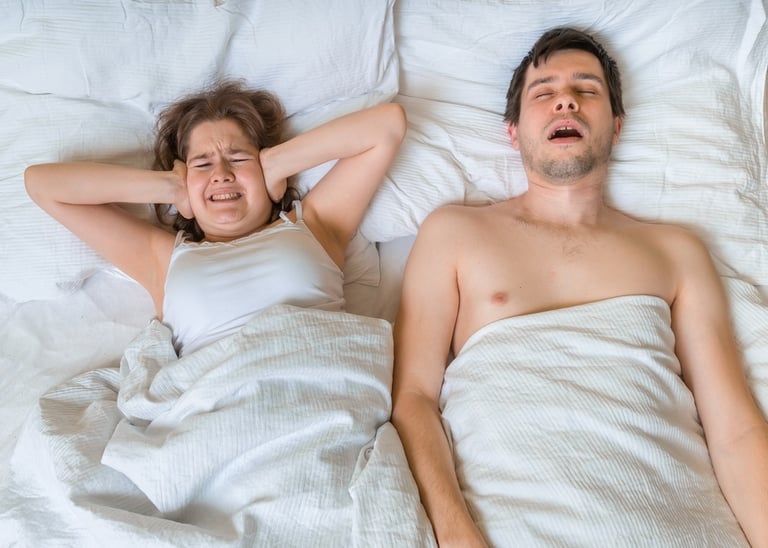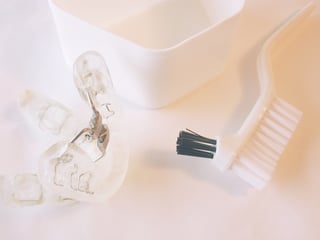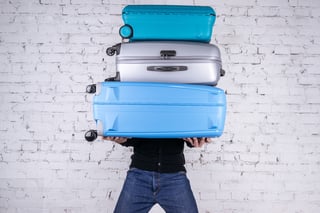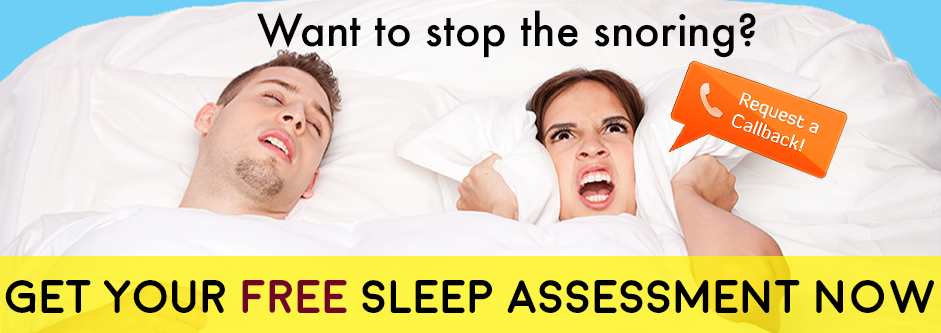
You saw wood all night long. You wake with a sore throat. Your bed partner is not looking so happy to see you at the breakfast table. Does this mean you need to start wearing a CPAP mask to bed every night? Not necessarily.
For many snorers or people with obstructive sleep apnea (OSA), an oral appliance can be a good first-line approach to opening your airway and helping you breath better — without the noise of snoring or the steady, all-night hum of a CPAP machine.
What Is Oral Appliance Therapy?
Oral therapy for snoring and apnea is exactly what it sounds like. If you have OSA or if you snore, your  sleep physician may recommend that you wear a custom-fitted oral device — a wearable mouthpiece or splint that looks like a sports mouth guard. This device is designed to keep your airway open when you sleep. It’s commonly referred to as a sleep apnea mouthpiece or snoring mouthpiece, and there are over 100 different styles currently approved by the FDA.
sleep physician may recommend that you wear a custom-fitted oral device — a wearable mouthpiece or splint that looks like a sports mouth guard. This device is designed to keep your airway open when you sleep. It’s commonly referred to as a sleep apnea mouthpiece or snoring mouthpiece, and there are over 100 different styles currently approved by the FDA.
Though designs of oral appliances vary slightly, the basic principle is this: the appliance is custom-fitted to your mouth and is designed to slide your lower jaw forward slightly — just enough to open up more space at the back of your throat. Making more room for your tongue and soft tissue eliminates the airway obstruction that leads to snoring and apneas (those instances when you stop breathing in your sleep, and possibly gasp yourself awake).
Does a Sleep Apnea Mouthpiece Actually Work?
Yes — for some people. Every individual who snores is different. The first step to determining if oral appliance therapy is likely to help you is to consult your physician, preferably a sleep specialist. Here’s the process:
- A sleep doctor will check to see if you are “just a snorer” or if you are likely to have sleep apnea.
- The specialist will examine you (and order a sleep study) to verify that your sleep apnea is obstructive — the type of apnea that’s caused by a mechanical airway obstruction in your throat and not by your central nervous system. (People with central sleep apnea will not benefit from a mouthpiece because their apnea is caused by the brain, not a physical blockage of the airway.)
- During your exam, your doctor may also measure your throat and jaw to make a conclusion about whether you’ll benefit from a device.
- If you have mild to moderate OSA and your doctor believes you’re a good candidate for an oral therapy approach, there’s a very good chance that the mouthpiece will be all you need to address your symptoms. Studies show that oral appliance therapy, if used correctly, is nearly as effective as CPAP therapy. In fact, the American Academy of Sleep Medicine (AASM) approves the use of oral appliance therapy for treating mild and moderate OSA.
- If you are diagnosed with severe OSA, CPAP therapy remains a more effective treatment for you. However, an oral appliance is considered a useful alternative for people with severe OSA who can’t tolerate CPAP for some reason. (Examples: if the mask is uncomfortable; if you have claustrophobia when wearing it; if the humming of the machine or the sound of the exhalations keep you awake; or if you repeatedly remove your mask in your sleep.)
- If you fit all the criteria for an oral device, your sleep specialist will refer you to a Sleep Medicine Dentist who can fit you for a mouthpiece. This medical professional is a regular dentist with expertise in using oral devices to help treat snoring, apnea, and other forms of sleep-disordered breathing. Over 2,800 dentists worldwide are trained to provide this service — so you’re almost guaranteed to have a qualified sleep medicine dentist where you live.
How to Get a Sleep Apnea Mouthpiece
Once you have your prescription in hand, be aware that the process of obtaining and fitting your oral appliance can take a few months. The process involves the following steps:
- Get an exam from your sleep specialist, during which you obtain a prescription for an oral device.
- Make an appointment to see a sleep medicine dentist about having an oral appliance made. (Check with your insurance to see if you need a referral to a specialist.)
- Get an exam from your sleep medicine dentist. The dentist will examine and measure your mouth,
 tongue, and throat. If you are approved for therapy, your dentist may make a separate appointment for a fitting.
tongue, and throat. If you are approved for therapy, your dentist may make a separate appointment for a fitting.
- Get fitted. At a fitting for your oral device, your dentist will take physical and possibly digital impressions of your mouth to create a model. These are then sent to a dental lab, where your appliance will be manufactured.
- Get adjusted. When the oral appliance is ready, visit your dentist again for a fitting, adjustments, and instructions on how to use and care for your mouthpiece.
- Follow-ups. Your sleep medicine dentist will schedule follow-ups with you as needed, to fine tune adjustments and to see if the therapy is helping you. You may need to undergo an additional sleep study to see if you are experiencing fewer apneas when wearing the device.
Why Oral Appliance Therapy is So Popular
More and more snorers and people with OSA are choosing to start with oral therapy instead of CPAP therapy, and the numbers increase every year as the technology improves.
One of the major reasons people look to mouthpieces as an alternative to CPAP is because it’s less intrusive and requires less upkeep.
Studies show that anywhere from 30 to 50% of CPAP users dislike treatment and reject their CPAPs within 1–3 weeks. Of course, it’s possible to stop using CPAP and and go back to it later — many people have trouble adjusting at first but eventually learn to get used to the feel of the mask and the routine of caring for the device.
But if you know you’re the type of person who’s never going to use the CPAP on a regular basis, a mouthpiece is an easy alternative. It allows you to comply with your therapy and protect your health without making huge adjustments to your bedtime routine or lifestyle.
Why is oral therapy so popular?
- Anti-snoring mouthpieces are small, lightweight, and come with their own cases. This portability makes
 them ideal for travel. Although you can travel with a CPAP, some people prefer to “travel light” and carry as little as possible, especially in this era of limited baggage on airplanes.
them ideal for travel. Although you can travel with a CPAP, some people prefer to “travel light” and carry as little as possible, especially in this era of limited baggage on airplanes.
- Mouthpieces are custom-fitted to your teeth and jaw, which makes them comfortable to wear. Some people who dislike the straps of a CPAP mask, for example, find a mouthpiece a welcome change. There’s also little contact with the skin or facial hair, for those who object to chafing or breakouts.
- Ease of Use. Oral appliances are very simple devices, similar to sports mouth guards. They’re lo-fi and don’t require batteries or outlets. Also, they require little care in comparison to CPAP, and they don’t require regular re-ordering of replacement parts.
- Style. Many people prefer to wear mouthpieces to bed because they feel they’re more discreet and carry less of a stigma than a CPAP mask and tubing. If feeling attractive matters to the user, a mouthpiece may be an improvement over a mask. It may look less like a medical device than the breathing machine on one’s bedside table.
- Wearing a mouthpiece is very quiet. A CPAP, on the other hand, blows air all night, which creates its own source of sound. (Much quieter than snoring, but light sleepers may still object.)
- Oral appliances are often less expensive than CPAP (though your insurance may cover both therapies).
Perhaps for all of these reasons, therapy compliance is high with oral devices.
Summary
If you snore or have OSA, there are many good reasons to treat your symptoms. Snorers need to worry about waking up with a sore throat and a grumpy bed partner. (Or if you snore really loudly, an entire grumpy household, building, dorm, or neighborhood.)
OSA patients need to worry about the health consequences of untreated sleep apnea. Diabetes, high blood pressure, heart problems, memory issues, brain damage, and chronic sleep deprivation (including drowsy driving) are just a few of the reasons you need to do something to address your condition.
If you really can’t stand CPAP, don’t give up. Used properly, oral therapy has a high compliance rate and is nearly as effective as CPAP.
A custom mouthpiece is a minor inconvenience that may save your life.











Leave a comment